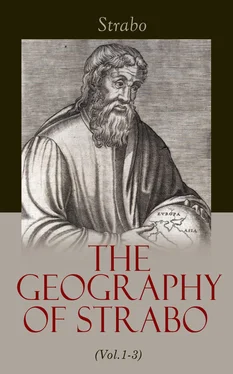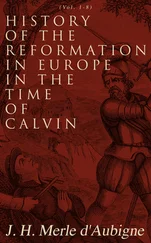Strabo - The Geography of Strabo (Vol.1-3)
Здесь есть возможность читать онлайн «Strabo - The Geography of Strabo (Vol.1-3)» — ознакомительный отрывок электронной книги совершенно бесплатно, а после прочтения отрывка купить полную версию. В некоторых случаях можно слушать аудио, скачать через торрент в формате fb2 и присутствует краткое содержание. Жанр: unrecognised, на английском языке. Описание произведения, (предисловие) а так же отзывы посетителей доступны на портале библиотеки ЛибКат.
- Название:The Geography of Strabo (Vol.1-3)
- Автор:
- Жанр:
- Год:неизвестен
- ISBN:нет данных
- Рейтинг книги:3 / 5. Голосов: 1
-
Избранное:Добавить в избранное
- Отзывы:
-
Ваша оценка:
- 60
- 1
- 2
- 3
- 4
- 5
The Geography of Strabo (Vol.1-3): краткое содержание, описание и аннотация
Предлагаем к чтению аннотацию, описание, краткое содержание или предисловие (зависит от того, что написал сам автор книги «The Geography of Strabo (Vol.1-3)»). Если вы не нашли необходимую информацию о книге — напишите в комментариях, мы постараемся отыскать её.
The Geography of Strabo (Vol.1-3) — читать онлайн ознакомительный отрывок
Ниже представлен текст книги, разбитый по страницам. Система сохранения места последней прочитанной страницы, позволяет с удобством читать онлайн бесплатно книгу «The Geography of Strabo (Vol.1-3)», без необходимости каждый раз заново искать на чём Вы остановились. Поставьте закладку, и сможете в любой момент перейти на страницу, на которой закончили чтение.
Интервал:
Закладка:
18. Hipparchus narrates that at the Dnieper and [the north of] Keltica, during the whole of the summer nights there is one continued twilight from sunset to sunrise, but at the winter solstice the sun never rises more than nine cubits above the horizon. 531He adds that this phenomenon is yet more remarkable in regions 6300 532stadia north of Marseilles, (these regions he supposes to be peopled by Kelts, but I believe are inhabited by Britons, and 2500 stadia north of Keltica,) where the sun at the winter solstice 533rises only six cubits above the horizon. That at 9100 534stadia north of Marseilles it only rises four cubits, and not so much as three in the countries beyond, and which I consider much farther north than Ierne. 535However, Hipparchus, on the authority of Pytheas, places them south of Britain, and says that the longest day there consists only of 19 hours; 536while in countries where the sun rises but four cubits above the horizon, and which are situated 9100 537stadia north of Marseilles, the day has 18 hours. Consequently [according to his hypothesis] the most southerly parts of Britain must be north of these regions. They must therefore be under the same parallel, or almost the same, as the parts of Bactriana next to the Caucasus, which I have shown are, according to the followers of Deimachus, 3800 stadia farther north than Ierne. 538Now if we add this to the number between Marseilles and Ierne, we shall get 12,500 stadia. But who ever made known to us that, in those parts, I mean, in the vicinity of Bactra, this was the duration of the longest day, or the height which the sun attains in the meridian at the winter solstice? All these things are patent to the eyes of every man, and require no mathematical investigation; therefore they certainly would have been mentioned by numerous writers both amongst the ancients who have left us histories of Persia, and by the later writers too, who have carried them down to our own time. How, too, would their fertility, which I have described above, harmonize with such a latitude? The facts here advanced are sufficient to give an idea of the learned manner in which Hipparchus attempts to controvert the reasoning of Eratosthenes by mere petitiones principii.
19. Again, Eratosthenes wished to show the ignorance of Deimachus, and his want of information concerning such matters, as proved by his assertion that India lies between the autumnal equinox 539and winter tropic. 540Also in his blaming Megasthenes, where he says that in the southern parts of India the Greater and Lesser Bear are seen to set, and the shadows to fall both ways; assuring us that such is not the case in India. 541These assertions, says Eratosthenes, arise from the ignorance of Deimachus. For it is nothing else than ignorance to suppose that the autumnal equinox is not equally distant from the tropics with the vernal; since in both equinoxes the sun rises at the same point, and performs a similar revolution. Further, [he continues,] the distance from the terrestrial tropic to the equator, between which, according to Deimachus himself, India is situated, has been proved by measurement to be much less than 20,000 stadia, consequently his own statements prove that my assertion is correct, and not his. For supposing India to be twenty or thirty thousand stadia [in breadth] it could not be contained in the given space, but if my estimate be taken it is simple enough. It is another evidence of his want of information, to say that the two Bears are not seen to set, or the shadows to fall both ways, in any part of India, since 5000 stadia south of Alexandria 542both of these phenomena are observable. Thus reasons Eratosthenes; whom Hipparchus again criticises in the same mistaken way. First he substitutes [in the text of Deimachus] the summer in place of the winter tropic; then he says that the evidence of a man ignorant of astronomy ought not to be received in a mathematical question; as if Eratosthenes in the main had actually been guided by the authority of Deimachus. Could he not see that Eratosthenes had followed the general custom in regard to idle reasoners, one means of refuting whom is to show that their arguments, whatever they may be, go only to confirm our views.
20. It is by assuming as a fact that the southern extremity of India is under the same parallel as Meroe, a thing affirmed and believed by most writers, that we shall be best able to show the absurdities of the system of Hipparchus. In the first book of his Commentaries he does not object to this hypothesis, but in the second book he no longer admits it; we must examine his reasons for this. He says, “when two countries are situated under the same parallel, but separated by a great distance, you cannot be certain that they are exactly under the same parallel, unless the climata 543of both the places are found to be similar. Now Philo, in his account of a voyage by sea to Ethiopia, has given us the clima of Meroe. He says that at that place the sun is vertical forty-five days before the summer solstice, 544he also informs us of the proportion of shadow thrown by the gnomon both at the equinoxes and solstices. Eratosthenes agrees almost exactly with Philo. But not a single writer, not even Eratosthenes, has informed us of the clima of India; but if it is the case, as many are inclined to believe on the authority of Nearchus, 545that the two Bears are seen to set in that country, then certainly Meroe and the southern extremity of India cannot be under the same parallel.” 546[Such is the reasoning of Hipparchus, but we reply,] If Eratosthenes confirms the statement of those authors who tell us that in India the two Bears are observed to set, how can it be said that not a single person, not even Eratosthenes, has informed us of any thing concerning the clima of India? This is itself information on that point. If, however, he has not confirmed this statement, let him be exonerated from the error. Certain it is he never did confirm the statement. Only when Deimachus affirmed that there was no place in India from which the two Bears might be seen to set, or the shadows fall both ways, as Megasthenes had asserted, Eratosthenes thereupon taxed him with ignorance, regarding as absolutely false this two-fold assertion, one half of which, namely, that concerning the shadows not falling both ways, Hipparchus himself acknowledged to be false; for if the southern extremity of India were not under the same parallel as Meroe, still Hipparchus appears to have considered it south of Syene.
21. In the instances which follow, Hipparchus, treating of these subjects, either asserts things similar to those which we have already refuted, or takes for granted matters which are not so, or draws improper sequences. For instance, from the computation [of Eratosthenes] that the distance from Babylon to Thapsacus 547is 4800 stadia, and thence northward to the mountains of Armenia 5482100 stadia more, it does not follow that, starting from the meridian of that city, the distance to the northern mountains is above 6000 stadia. Besides, Eratosthenes never says that the distance from Thapsacus to these mountains is 2100 stadia, but that a part thereof has never yet been measured; so that this argument [of Hipparchus], founded on a false hypothesis, amounts to nothing. Nor did Eratosthenes ever assert that Thapsacus lies more than 4500 stadia north of Babylon.
22. Again, Hipparchus, ever anxious to defend the [accuracy of the] ancient charts, instead of fairly stating the words of Eratosthenes concerning his third section of the habitable earth, wilfully makes him the author of an assertion easy of disproof. For Eratosthenes, following the opinion we before mentioned, that a line drawn from the Pillars of Hercules across the Mediterranean, and the length of the Taurus, would run due west and east, 549divides, by means of this line, the habitable earth into two portions, which he calls the northern and southern divisions; each of these he again essays to subdivide into as many smaller partitions as practicable, which he denominates sections. 550He makes India the first section of the southern part, and Ariana 551the second; these two countries possessing a good outline, he has been able not only to give us an accurate statement of their length and breadth, but an almost geometrically exact description of their figure. He tells us that the form of India is rhomboidal, being washed on two of its sides by the southern and eastern oceans [respectively], which do not deeply indent its shores. The two remaining sides are contained by its mountains and the river [Indus], so that it presents a kind of rectilinear figure. 552As to Ariana, he considered three of its sides well fitted to form a parallelogram; but of the western side he could give no regular definition, as it was inhabited by various nations; nevertheless he attempts an idea of it by a line drawn from the Caspian Gates 553to the limits of Carmania, which border on the Persian Gulf. This side he calls western, and that next the Indus eastern, but he does not tell us they are parallel to each other; neither does he say this of the other sides, one bounded by the mountains, and the other by the sea; he simply calls them north and south.
Читать дальшеИнтервал:
Закладка:
Похожие книги на «The Geography of Strabo (Vol.1-3)»
Представляем Вашему вниманию похожие книги на «The Geography of Strabo (Vol.1-3)» списком для выбора. Мы отобрали схожую по названию и смыслу литературу в надежде предоставить читателям больше вариантов отыскать новые, интересные, ещё непрочитанные произведения.
Обсуждение, отзывы о книге «The Geography of Strabo (Vol.1-3)» и просто собственные мнения читателей. Оставьте ваши комментарии, напишите, что Вы думаете о произведении, его смысле или главных героях. Укажите что конкретно понравилось, а что нет, и почему Вы так считаете.












![Anne Blunt - A Pilgrimage to Nejd, the Cradle of the Arab Race. Vol. 2 [of 2]](/books/750183/anne-blunt-a-pilgrimage-to-nejd-the-cradle-of-the-thumb.webp)